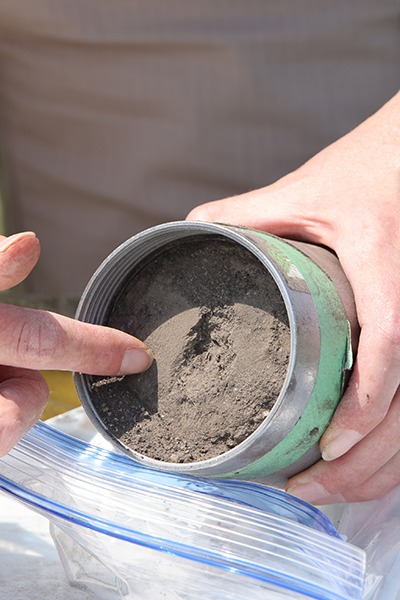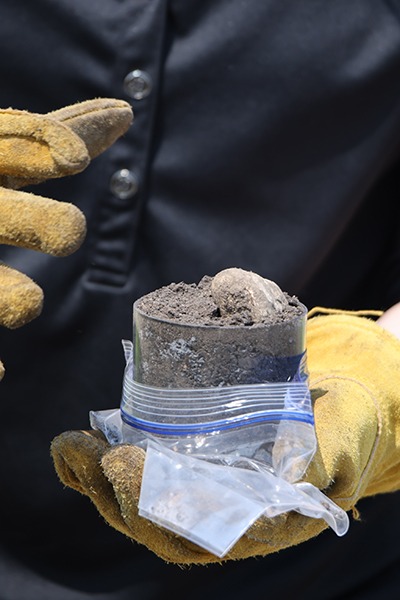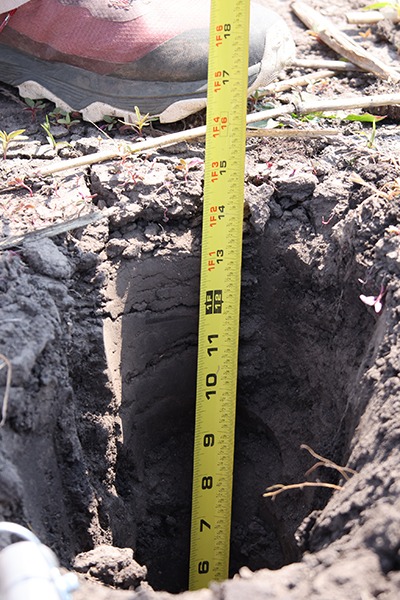How Does Compaction Impact Water Availability for Plants?
This article was adapted from “Assessing Soil Health: Soil Water Cycling” first published on September 7, 2020 in Crops & Soils magazine. You can find the original article here.
The short answer: Compacted soils increase surface runoff and make it more difficult for water to flow to plant roots.
The big picture: Compaction is the squishing of soil particles closer together, decreasing the amount of pore space available.
- Pore space is the gaps between soil particles. Larger pores more effectively move water downward through the soil, compared to smaller pores.
- This makes it more difficult for water to get into the soil, which means that any water from rainfall or irrigation isn’t getting to where plants need it most—their roots!
Think of it like pouring water into a sieve. The bigger the holes, the faster water flows. But if you pour water into a sieve with a cloth over it, that water will flow much more slowly. And like a sieve covered with a cloth, the soil will stay wetter for much longer, with less oxygen available to plant roots and increased increased risk of root diseases.
Back it up: What causes compaction?
- Wet soils are the most prone to potential compaction, both near the surface and at the subsurface level.
- Paying attention to proper soil moisture conditions is key. Iowa State Extension has a super quick check: make a two-inch diameter ball of soil, and toss it in the air. If it holds together until it hits the ground, the soil is still too wet—avoid traffic on the field.
Measuring soil compaction using a penetrometer is an inexpensive method that can give you a sense of what roots, water, and air encounter in the soil.
- Penetrometers measure penetration resistance, which is a function of compaction, soil texture, organic matter content, and moisture content in the soil.
- Because of these many factors, penetrometer measurements can be hard to compare over time. Taking side-by-side tests under the same conditions gives you the best comparison.
Bulk density measurements are a more repeatable option over space and time.
- The Soil Health Institute recommends using a 3-inch-diameter soil core, and these samples along with soil carbon content can also be used to quantify organic carbon stock.
Break it down: Say your soils are a bit compacted. How do you improve them?
- The best cure for compaction is prevention! Avoid machinery traffic on fields that are still wet.
- After that, adopting soil health practices that build aggregate stability and pore space. Try reducing or decreasing tillage, adopting cover crops, and leaving residue on the field are all great ways to combat compaction.
- In some cases, a farmer may need to use deep tillage to break up compaction. After using that strategic tillage to break up compaction, it’s important to implement soil health management practices and avoid traffic on wet soil to prevent more compaction and costly tillage.
In short, compaction limits air, water, and root penetration into the soil. Compaction can be tricky to reverse–prevention is the best medicine. Make yourself aware of the signs of compacted soils, and try some of the ways recommended above to reduce compaction. Your pore space will thank you!
Photo courtesy of NRCS/SWCS by Lynn Betts.








